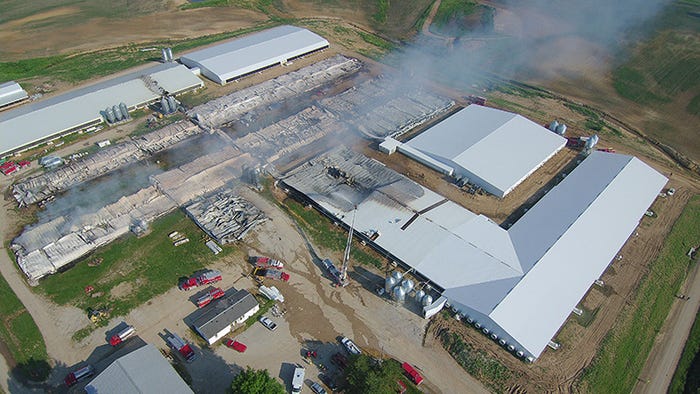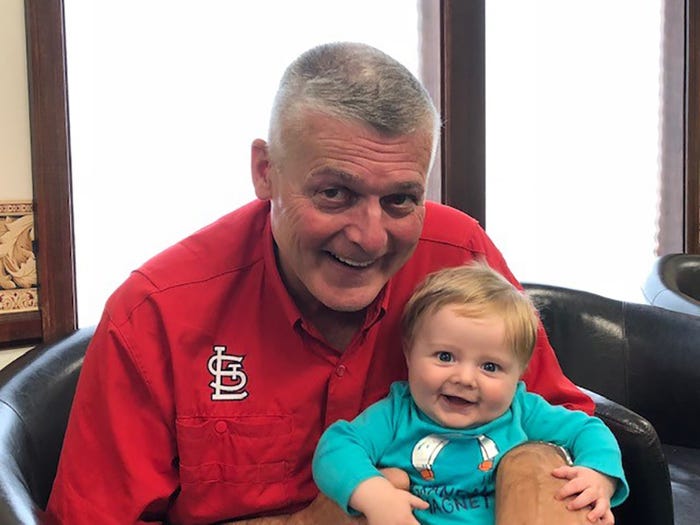The 5 a.m. wake-up call from a passerby was one Phil Borgic never expected, but when the internet alarm systems in the office were swallowed up in the fire, that knock on the door was his only warning.

There were more than 70 potential spots in Phil Borgic’s office that could have started the fire those early morning hours on May 25, but it only took one spark to consume almost three acres of buildings on his southwestern Illinois 6,000 breed-to-wean operation.
The 5 a.m. wake-up call from a passerby was one Borgic never expected, but when the internet alarm systems in the office were swallowed up in the fire, that knock on the door was his only warning.
While the Borgics didn’t lose the whole farm that day and no one was injured, the devastating event set a whole response chain in motion. Sixteen different fire departments were involved, more than 200 people showed up to help and an emergency management plan was executed with the Borgic family, Borgic Farms staff and herd veterinarians actively involved.
“As Christians, we are taught that you give, and you will receive,” Borgic says. “We received tenfold that day.”
Borgic wasn’t completely caught off guard and did have some pre-planning in place before the fire, including an updated insurance plan. However, he did learn many lessons that day and, in the weeks following, on how to handle a crisis such as this. Now more than six months later, the swine producer with more than 35 years’ experience in the business, is sharing his tips with fellow farmers in the hope they never have to experience anything like this, but if that day should come, they are prepared.
Pre-planning
Update insurance
Make sure to update coverages for the actual replacement cost of the buildings. Building costs can change and different buildings can be worth more. For example, the Borgics’ gestation unit was covered for $1,000 per space while the lactation building was set for $3,000 per space.
Build concrete hallways, use non-flammable materials
Borgic says fire stops do work. He had recently installed them in his newer buildings and they slowed the progression of the fire.
Install redundant warning systems
Borgic encourages farms to have internet-based as well as telephone or cellular-based. In their case, they had two internet services, and both were located in the office. By being in the office, where the fire started, the Borgics lost both of their systems. Locate the base units in different parts of your building if possible.
Select the spokesperson
Every farm should have people designated who are trained to formulate and deliver the message. When a crisis hits, that person needs to ensure the right story is being told and the information is accurate.
Get to know your fire department
Invite them to the farm and give them a scope of what they will be dealing with in case of an emergency, Borgic says. By knowing the size of the farm, additional departments and resources can be called, which can reduce response time. Show them where the water sources and equipment are on the property.
Prepare your team
Does your staff know where the gas shut-off valves are located? Do they know where the electrical shut-offs are located? All of these measures are important for staff to be educated on in case of an emergency and should be regularly practiced around the farm.

While the Borgics didn’t lose the whole farm that day and no one was injured, the devastating event set a whole response chain in motion.
During the crisis
Do a headcount
If the event happens during work hours, have a list of team members and find each of them.
Logistics
Coordinate with first responders and designate responsibilities for animal movement, equipment and people. Contact local law enforcement to help with traffic and work with the fire departments on moving trucks in and out of the farm. Borgic says one area that is essential is to have a clear entrance and exit route to get full water trucks in and empty water trucks out.
Make a statement
Review your already prepared message and decide who will deliver it and what resources they will need. For instance, the Borgics were fortunate that the Illinois Pork Producers Association helped issue a public statement on their behalf.
Take notes
Borgic says there is a lot of follow-up after the event. Keep track of who showed up to help, who donated, what you had to purchase to get through the event. He says you will want it someday.
Call in the backups
Animals may need to be moved to another location. Is there space outside your system that could temporarily house them? Keep a list of trucking companies, especially ones you don’t normally use, to get needed trucks and trailers on site. Know who to contact to get animals into a plant if additional market loads need to be sold to make space.
Borgic says also be prepared for “too much help.” He suggests rotating load and unload crews, so they get a break and keeping “extra” people out of the way.

Borgic and his grandson, Grayson Joseph Bockewitz, who was born a few days before the fire.
Post fire
Animal care
Borgic says it was vital to have veterinarians on site to assist with individual animal care needs. The expertise helped them make tough decisions on which ones to treat or euthanize.
Get the right authorities involved
For example, after the fire the Borgics had to contact the Illinois Department of Agriculture for mortality and manure management issues. They had to contact Illinois Environmental Protection Agency for demolition and discharges. Different states have different regulations to follow.
Follow up
What public statements do you need to make after the event? How is your team coping? Do they need assistance? Who needs a thank you?
About the Author(s)
You May Also Like





